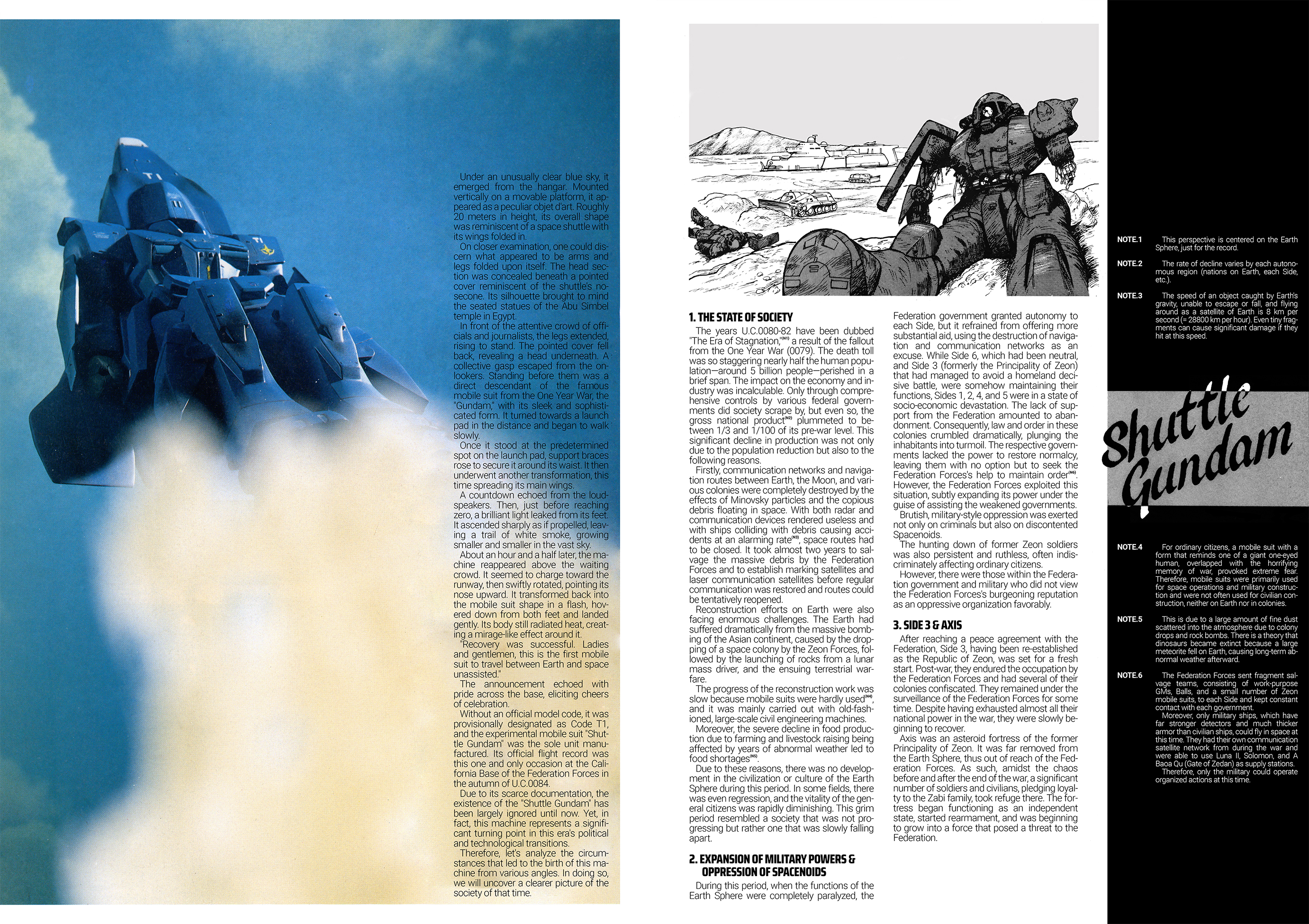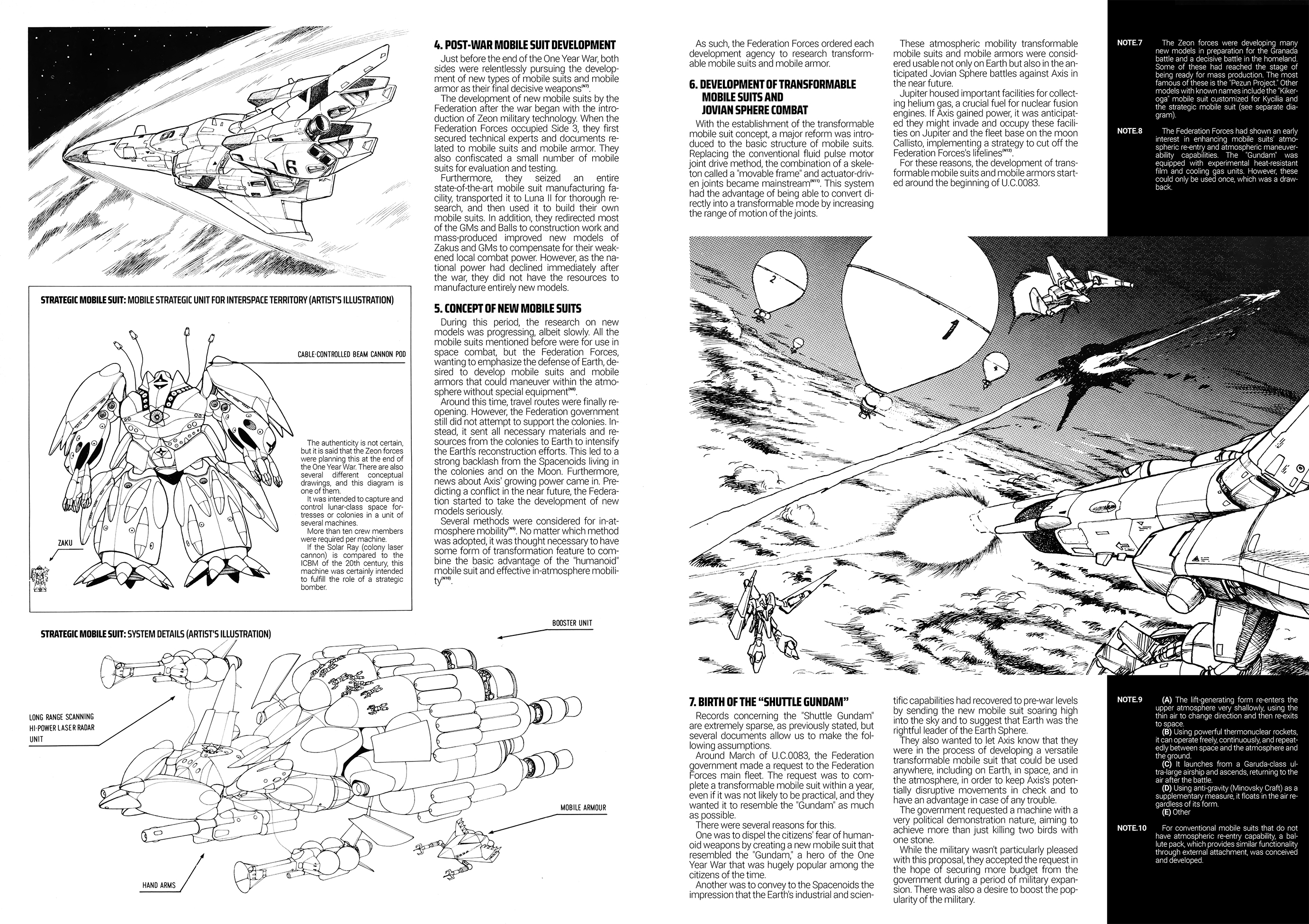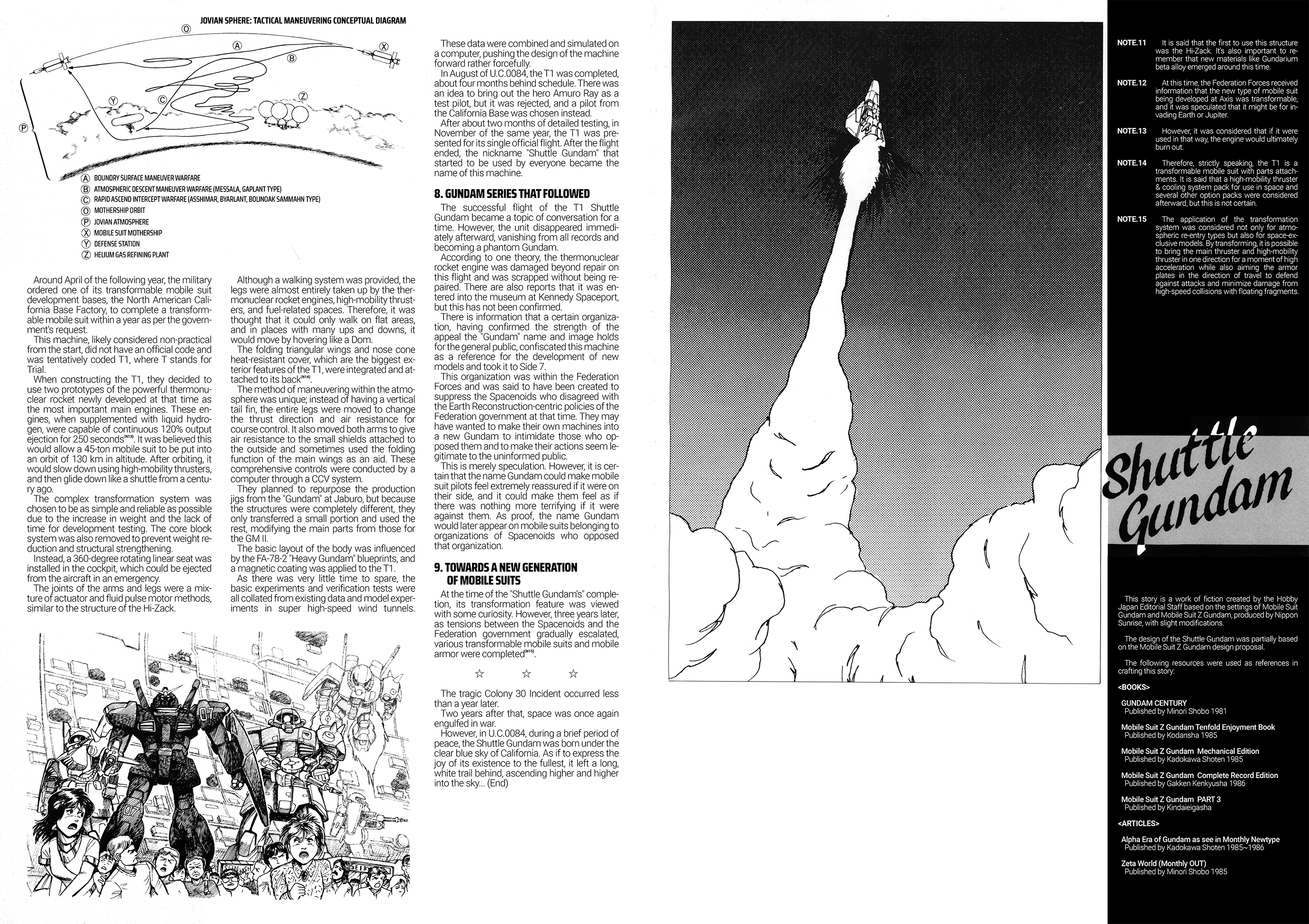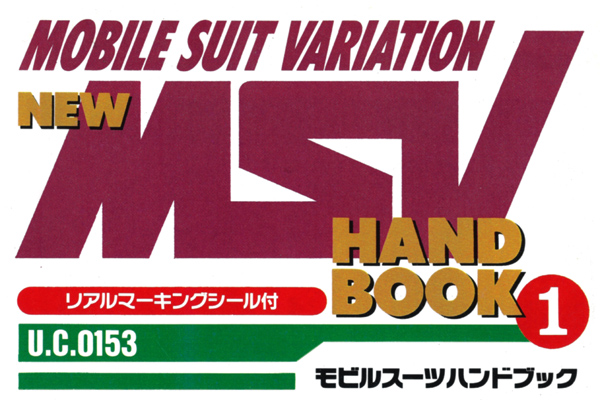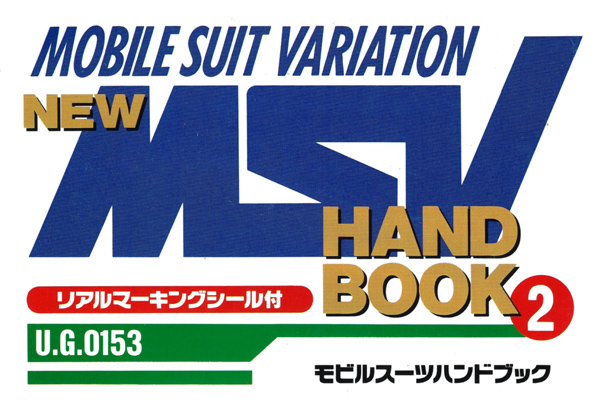ORIGINAL MOBILE SUIT STORY: SHUTTLE GUNDAM
Composition by Hobby Japan Editorial Department
Text by Naoki Yamamoto
Illustration by Kunio Aoi and Kiyomi Tanaka
Model Production by Yuji Kitano
ORIGINAL MOBILE SUIT STORY: SHUTTLE GUNDAM
Under an unusually clear blue sky, it emerged from the hangar. Mounted vertically on a movable platform, it appeared as a peculiar objet d’art. Roughly 20 meters in height, its overall shape was reminiscent of a space shuttle with its wings folded in.
On closer examination, one could discern what appeared to be arms and legs folded upon itself. The head section was concealed beneath a pointed cover reminiscent of the shuttle’s nosecone. Its silhouette brought to mind the seated statues of the Abu Simbel temple in Egypt.
In front of the attentive crowd of officials and journalists, the legs extended, rising to stand. The pointed cover fell back, revealing a head underneath. A collective gasp escaped from the onlookers. Standing before them was a direct descendant of the famous mobile suit from the One Year War, the “Gundam,” with its sleek and sophisticated form. It turned towards a launch pad in the distance and began to walk slowly.
Once it stood at the predetermined spot on the launch pad, support braces rose to secure it around its waist. It then underwent another transformation, this time spreading its main wings.
A countdown echoed from the loudspeakers. Then, just before reaching zero, a brilliant light leaked from its feet. It ascended sharply as if propelled, leaving a trail of white smoke, growing smaller and smaller in the vast sky.
About an hour and a half later, the machine reappeared above the waiting crowd. It seemed to charge toward the runway, then swiftly rotated, pointing its nose upward. It transformed back into the mobile suit shape in a flash, hovered down from both feet and landed gently. Its body still radiated heat, creating a mirage-like effect around it.
“Recovery was successful. Ladies and gentlemen, this is the first mobile suit to travel between Earth and space unassisted.”
The announcement echoed with pride across the base, eliciting cheers of celebration.
Without an official model code, it was provisionally designated as Code T1, and the experimental mobile suit “Shuttle Gundam” was the sole unit manufactured. Its official flight record was this one and only occasion at the California Base of the Federation Forces in the autumn of U.C.0084.
Due to its scarce documentation, the existence of the “Shuttle Gundam” has been largely ignored until now. Yet, in fact, this machine represents a significant turning point in this era’s political and technological transitions.
Therefore, let’s analyze the circumstances that led to the birth of this machine from various angles. In doing so, we will uncover a clearer picture of the society of that time.
![]()
1. THE STATE OF SOCIETY
The years U.C.0080-82 have been dubbed “The Era of Stagnation,”(N1) a result of the fallout from the One Year War (0079). The death toll was so staggering nearly half the human population—around 5 billion people—perished in a brief span. The impact on the economy and industry was incalculable. Only through comprehensive controls by various federal governments did society scrape by, but even so, the gross national product(N2) plummeted to between 1/3 and 1/100 of its pre-war level. This significant decline in production was not only due to the population reduction but also to the following reasons.
Firstly, communication networks and navigation routes between Earth, the Moon, and various colonies were completely destroyed by the effects of Minovsky particles and the copious debris floating in space. With both radar and communication devices rendered useless and with ships colliding with debris causing accidents at an alarming rate(N3), space routes had to be closed. It took almost two years to salvage the massive debris by the Federation Forces and to establish marking satellites and laser communication satellites before regular communication was restored and routes could be tentatively reopened.
Reconstruction efforts on Earth were also facing enormous challenges. The Earth had suffered dramatically from the massive bombing of the Asian continent, caused by the dropping of a space colony by the Zeon Forces, followed by the launching of rocks from a lunar mass driver, and the ensuing terrestrial warfare.
The progress of the reconstruction work was slow because mobile suits were hardly used(N4), and it was mainly carried out with old-fashioned, large-scale civil engineering machines.
Moreover, the severe decline in food production due to farming and livestock raising being affected by years of abnormal weather led to food shortages(N5).
Due to these reasons, there was no development in the civilization or culture of the Earth Sphere during this period. In some fields, there was even regression, and the vitality of the general citizens was rapidly diminishing. This grim period resembled a society that was not progressing but rather one that was slowly falling apart.
2. EXPANSION OF MILITARY POWERS & SUPPRESSION OF SPACENOIDS
During this period, when the functions of the Earth Sphere were completely paralyzed, the Federation government granted autonomy to each Side, but it refrained from offering more substantial aid, using the destruction of navigation and communication networks as an excuse. While Side 6, which had been neutral, and Side 3 (formerly the Principality of Zeon) that had managed to avoid a homeland decisive battle, were somehow maintaining their functions, Sides 1, 2, 4, and 5 were in a state of socio-economic devastation. The lack of support from the Federation amounted to abandonment. Consequently, law and order in these colonies crumbled dramatically, plunging the inhabitants into turmoil. The respective governments lacked the power to restore normalcy, leaving them with no option but to seek the Federation Forces’s help to maintain order(N6). However, the Federation Forces exploited this situation, subtly expanding its power under the guise of assisting the weakened governments.
Brutish, military-style oppression was exerted not only on criminals but also on discontented Spacenoids.
The hunting down of former Zeon soldiers was also persistent and ruthless, often indiscriminately affecting ordinary citizens.
However, there were those within the Federation government and military who did not view the Federation Forces’s burgeoning reputation as an oppressive organization favorably.
3. SIDE 3 & AXIS
After reaching a peace agreement with the Federation, Side 3, having been re-established as the Republic of Zeon, was set for a fresh start. Post-war, they endured the occupation by the Federation Forces and had several of their colonies confiscated. They remained under the surveillance of the Federation Forces for some time. Despite having exhausted almost all their national power in the war, they were slowly beginning to recover.
Axis was an asteroid fortress of the former Principality of Zeon. It was far removed from the Earth Sphere, thus out of reach of the Federation Forces. As such, amidst the chaos before and after the end of the war, a significant number of soldiers and civilians, pledging loyalty to the Zabi family, took refuge there. The fortress began functioning as an independent state, started rearmament, and was beginning to grow into a force that posed a threat to the Federation.
4. POST-WAR MOBILE SUIT DEVELOPMENT
Just before the end of the One Year War, both sides were relentlessly pursuing the development of new types of mobile suits and mobile armor as their final decisive weapons(N7).
The development of new mobile suits by the Federation after the war began with the introduction of Zeon military technology. When the Federation Forces occupied Side 3, they first secured technical experts and documents related to mobile suits and mobile armor. They also confiscated a small number of mobile suits for evaluation and testing.
Furthermore, they seized an entire state-of-the-art mobile suit manufacturing facility, transported it to Luna II for thorough research, and then used it to build their own mobile suits. In addition, they redirected most of the GMs and Balls to construction work and mass-produced improved new models of Zakus and GMs to compensate for their weakened local combat power. However, as the national power had declined immediately after the war, they did not have the resources to manufacture entirely new models.
5. CONCEPT OF NEW MOBILE SUITS
During this period, the research on new models was progressing, albeit slowly. All the mobile suits mentioned before were for use in space combat, but the Federation Forces, wanting to emphasize the defense of Earth, desired to develop mobile suits and mobile armors that could maneuver within the atmosphere without special equipment(N8).
Around this time, travel routes were finally reopening. However, the Federation government still did not attempt to support the colonies. Instead, it sent all necessary materials and resources from the colonies to Earth to intensify the Earth’s reconstruction efforts. This led to a strong backlash from the Spacenoids living in the colonies and on the Moon. Furthermore, news about Axis’ growing power came in. Predicting a conflict in the near future, the Federation started to take the development of new models seriously.
Several methods were considered for in-atmosphere mobility(N9). No matter which method was adopted, it was thought necessary to have some form of transformation feature to combine the basic advantage of the “humanoid” mobile suit and effective in-atmosphere mobility(N10).
As such, the Federation Forces ordered each development agency to research transformable mobile suits and mobile armor.
6. DEVELOPMENT OF MOBILE SUITS AND JOVIAN SPHERE COMBAT
With the establishment of the transformable mobile suit concept, a major reform was introduced to the basic structure of mobile suits. Replacing the conventional fluid pulse motor joint drive method, the combination of a skeleton called a “movable frame” and actuator-driven joints became mainstream(N11). This system had the advantage of being able to convert directly into a transformable mode by increasing the range of motion of the joints.
These atmospheric mobility transformable mobile suits and mobile armors were considered usable not only on Earth but also in the anticipated Jovian Sphere battles against Axis in the near future.
Jupiter housed important facilities for collecting helium gas, a crucial fuel for nuclear fusion engines. If Axis gained power, it was anticipated they might invade and occupy these facilities on Jupiter and the fleet base on the moon Callisto, implementing a strategy to cut off the Federation Forces’ lifelines(N12).
For these reasons, the development of transformable mobile suits and mobile armors started around the beginning of U.C.0083.
7. BIRTH OF THE “SHUTTLE GUNDAM”
Records concerning the “Shuttle Gundam” are extremely sparse, as previously stated, but several documents allow us to make the following assumptions.
Around March of U.C.0083, the Federation government made a request to the Federation Forces main fleet. The request was to complete a transformable mobile suit within a year, even if it was not likely to be practical, and they wanted it to resemble the “Gundam” as much as possible.
There were several reasons for this.
One was to dispel the citizens’ fear of humanoid weapons by creating a new mobile suit that resembled the “Gundam,” a hero of the One Year War that was hugely popular among the citizens of the time.
Another was to convey to the Spacenoids the impression that the Earth’s industrial and scientific capabilities had recovered to pre-war levels by sending the new mobile suit soaring high into the sky and to suggest that Earth was the rightful leader of the Earth Sphere.
They also wanted to let Axis know that they were in the process of developing a versatile transformable mobile suit that could be used anywhere, including on Earth, in space, and in the atmosphere, in order to keep Axis’s potentially disruptive movements in check and to have an advantage in case of any trouble.
The government requested a machine with a very political demonstration nature, aiming to achieve more than just killing two birds with one stone.
While the military wasn’t particularly pleased with this proposal, they accepted the request in the hope of securing more budget from the government during a period of military expansion. There was also a desire to boost the popularity of the military.
Around April of the following year, the military ordered one of its transformable mobile suit development bases, the North American California Base Factory, to complete a transformable mobile suit within a year as per the government’s request.
This machine, likely considered non-practical from the start, did not have an official code and was tentatively coded T1, where T stands for Trial.
When constructing the T1, they decided to use two prototypes of the powerful thermonuclear rocket newly developed at that time as the most important main engines. These engines, when supplemented with liquid hydrogen, were capable of continuous 120% output ejection for 250 seconds(N13). It was believed this would allow a 45-ton mobile suit to be put into an orbit of 130 km in altitude. After orbiting, it would slow down using high-mobility thrusters, and then glide down like a shuttle from a century ago.
The complex transformation system was chosen to be as simple and reliable as possible due to the increase in weight and the lack of time for development testing. The core block system was also removed to prevent weight reduction and structural strengthening.
Instead, a 360-degree rotating linear seat was installed in the cockpit, which could be ejected from the aircraft in an emergency.
The joints of the arms and legs were a mixture of actuator and fluid pulse motor methods, similar to the structure of the Hi-Zack.
Although a walking system was provided, the legs were almost entirely taken up by the thermonuclear rocket engines, high-mobility thrusters, and fuel-related spaces. Therefore, it was thought that it could only walk on flat areas, and in places with many ups and downs, it would move by hovering like a Dom.
The folding triangular wings and nose cone heat-resistant cover, which are the biggest exterior features of the T1, were integrated and attached to its back(N14).
The method of maneuvering within the atmosphere was unique; instead of having a vertical tail fin, the entire legs were moved to change the thrust direction and air resistance for course control. It also moved both arms to give air resistance to the small shields attached to the outside and sometimes used the folding function of the main wings as an aid. These comprehensive controls were conducted by a computer through a CCV system.
They planned to repurpose the production jigs from the “Gundam” at Jaburo, but because the structures were completely different, they only transferred a small portion and used the rest, modifying the main parts from those for the GM II.
The basic layout of the body was influenced by the FA-78-2 “Heavy Gundam” blueprints, and a magnetic coating was applied to the T1.
As there was very little time to spare, the basic experiments and verification tests were all collated from existing data and model experiments in super high-speed wind tunnels.
These data were combined and simulated on a computer, pushing the design of the machine forward rather forcefully.
In August of U.C.0084, the T1 was completed, about four months behind schedule. There was an idea to bring out the hero Amuro Ray as a test pilot, but it was rejected, and a pilot from the California Base was chosen instead.
After about two months of detailed testing, in November of the same year, the T1 was presented for its single official flight. After the flight ended, the nickname “Shuttle Gundam” that started to be used by everyone became the name of this machine.
8. GUNDAM SERIES THAT FOLLOWED
The successful flight of the T1 Shuttle Gundam became a topic of conversation for a time. However, the unit disappeared immediately afterward, vanishing from all records and becoming a phantom Gundam.
According to one theory, the thermonuclear rocket engine was damaged beyond repair on this flight and was scrapped without being repaired. There are also reports that it was entered into the museum at Kennedy Spaceport, but this has not been confirmed.
There is information that a certain organization, having confirmed the strength of the appeal the “Gundam” name and image holds for the general public, confiscated this machine as a reference for the development of new models and took it to Side 7.
This organization was within the Federation Forces and was said to have been created to suppress the Spacenoids who disagreed with the Earth Reconstruction-centric policies of the Federation government at that time. They may have wanted to make their own machines into a new Gundam to intimidate those who opposed them and to make their actions seem legitimate to the uninformed public.
This is merely speculation. However, it is certain that the name Gundam could make mobile suit pilots feel extremely reassured if it were on their side, and it could make them feel as if there was nothing more terrifying if it were against them. As proof, the name Gundam would later appear on mobile suits belonging to organizations of Spacenoids who opposed that organization.
9. TOWARDS A NEW GENERATION OF MOBILE SUITS
At the time of the “Shuttle Gundam’s” completion, its transformation feature was viewed with some curiosity. However, three years later, as tensions between the Spacenoids and the Federation government gradually escalated, various transformable mobile suits and mobile armor were completed(N15).
☆ ☆ ☆
The tragic Colony 30 Incident occurred less than a year later.
Two years after that, space was once again engulfed in war.
However, in U.C.0084, during a brief period of peace, the Shuttle Gundam was born under the clear blue sky of California. As if to express the joy of its existence to the fullest, it left a long, white trail behind, ascending higher and higher into the sky… (End)
![]()
EXPLANATION OF NOTES
NOTE.1 This perspective is centered on the Earth Sphere, just for the record.
NOTE.2 The rate of decline varies by each autonomous region (nations on Earth, each Side, etc.).
NOTE.3 The speed of an object caught by Earth’s gravity, unable to escape or fall, and flying around as a satellite of Earth is 8 km per second (= 28800 km per hour). Even tiny fragments can cause significant damage if they hit at this speed.
NOTE.4 For ordinary citizens, a mobile suit with a form that reminds one of a giant one-eyed human, overlapped with the horrifying memory of war, provoked extreme fear. Therefore, mobile suits were primarily used for space operations and military construction and were not often used for civilian construction, neither on Earth nor in colonies.
NOTE.5 This is due to a large amount of fine dust scattered into the atmosphere due to colony drops and rock bombs. There is a theory that dinosaurs became extinct because a large meteorite fell on Earth, causing long-term abnormal weather afterward.
NOTE.6 The Federation Forces sent fragment salvage teams, consisting of work-purpose GMs, Balls, and a small number of Zeon mobile suits, to each Side and kept constant contact with each government. Moreover, only military ships, which have far stronger detectors and much thicker armor than civilian ships, could fly in space at this time. They had their own communication satellite network from during the war and were able to use Luna II, Solomon, and A Baoa Qu (Gate of Zedan) as supply stations. Therefore, only the military could operate organized actions at this time.
NOTE.7 The Zeon forces were developing many new models in preparation for the Granada battle and a decisive battle in the homeland. Some of these had reached the stage of being ready for mass production. The most famous of these is the “Pezun Project.” Other models with known names include the “Kikeroga” mobile suit customized for Kycilia and the strategic mobile suit (see separate diagram).
NOTE.8 The Federation Forces had shown an early interest in enhancing mobile suits’ atmospheric re-entry and atmospheric maneuverability capabilities. The “Gundam” was equipped with experimental heat-resistant film and cooling gas units. However, these could only be used once, which was a drawback.
NOTE.9 (A) The lift-generating form re-enters the upper atmosphere very shallowly, using the thin air to change direction and then re-exits to space.
(B) Using powerful thermonuclear rockets, it can operate freely, continuously, and repeatedly between space and the atmosphere and the ground.
(C) It launches from a Garuda-class ultra-large airship and ascends, returning to the air after the battle.
(D) Using anti-gravity (Minovsky Craft) as a supplementary measure, it floats in the air regardless of its form.
(E) Other
NOTE.10 For conventional mobile suits that do not have atmospheric re-entry capability, a ballute pack, which provides similar functionality through external attachment, was conceived and developed.
NOTE.11 It is said that the first to use this structure was the Hi-Zack. It’s also important to remember that new materials like Gundarium beta alloy emerged around this time.
NOTE.12 At this time, the Federation Forces received information that the new type of mobile suit being developed at Axis was transformable, and it was speculated that it might be for invading Earth or Jupiter.
NOTE.13 However, it was considered that if it were used in that way, the engine would ultimately burn out.
NOTE.14 Therefore, strictly speaking, the T1 is a transformable mobile suit with parts attachments. It is said that a high-mobility thruster & cooling system pack for use in space and several other option packs were considered afterward, but this is not certain.
NOTE.15 The application of the transformation system was considered not only for atmospheric re-entry types but also for space-exclusive models. By transforming, it is possible to bring the main thruster and high-mobility thruster in one direction for a moment of high acceleration while also aiming the armor plates in the direction of travel to defend against attacks and minimize damage from high-speed collisions with floating fragments.
![]()





